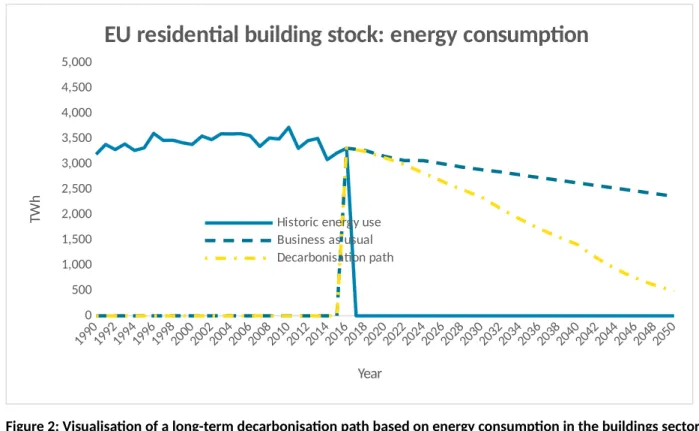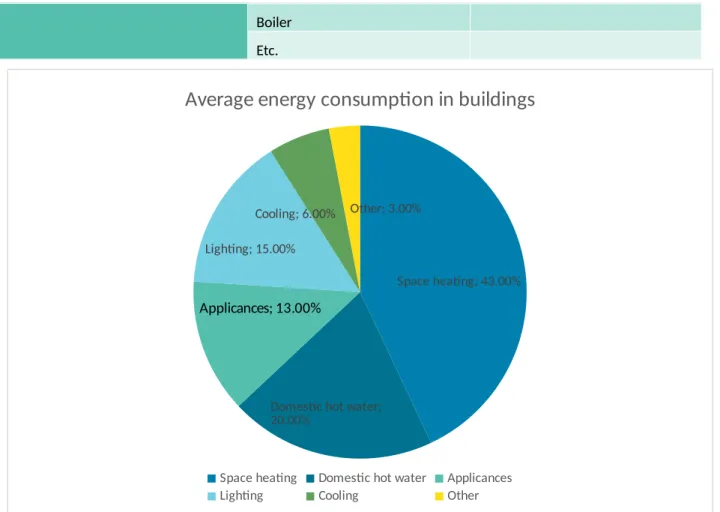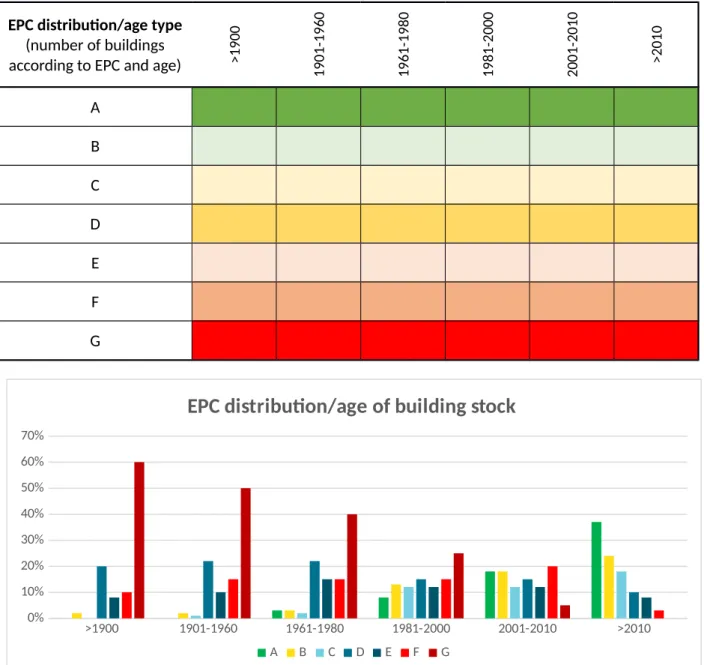This project is part of the European Climate Initiative (EUKI) of the German Federal Ministry for the Environment, Nature Conservation and Nuclear Safety (BMU). National governments are expected by 10 March 2020 to establish "long-term renovation strategies for mobilizing investment in the renovation of the national stock of residential and commercial buildings, both public and private".
Roadmap
Long-term renewal strategies should provide targets and measures that will lead to a highly energy-efficient and decarbonised building stock by 2050. The table below presents some possible milestones that can be easily measured based on the information that is already needed to be included and updated under "Building Stock Overview".
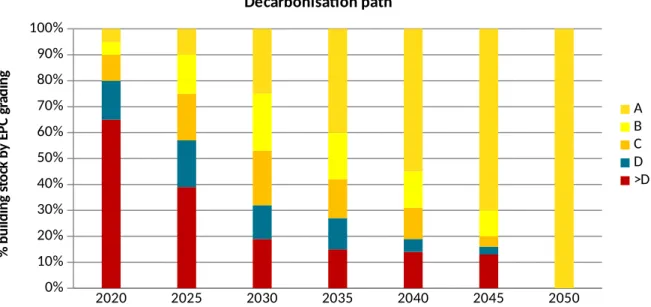
Overview of the national building stock
Composition of the building stock
The average age of buildings and the share of new buildings in the total stock represent good indicators of the average efficiency of the building stock: the higher the share of recent housing (i.e. built to more efficient standards), the higher the energy performance of the buildings. stock. In addition to the requirements already existing under Article 4(a) EED, Member States will now have to include the expected share of renovated buildings in 2020 in their overview of the national building stock.
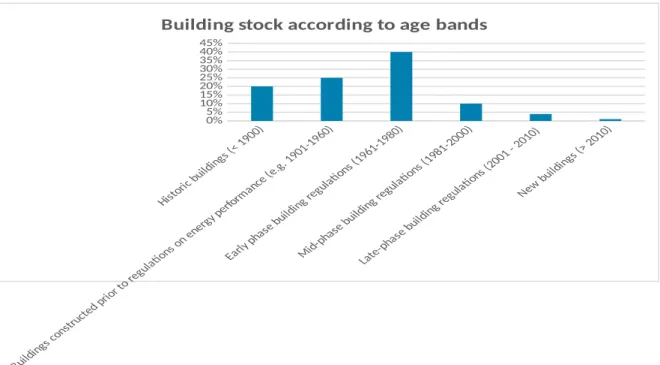
Identification of worst-performing segments of the building stock
If there are 9 building types and 5 age ranges, this results in a matrix of up to 45 combinations. However, it will be possible to group many of the business building types/age bands, so the number of combinations will in practice be less than this. Step 5a: Identify breakdown by owner – public/private/mixed Step 5b: Identify breakdown by ownership – owner . recorded/rented/mixed.
Some of this information may be difficult to obtain, especially for old buildings and those that have been partially renovated over time. The purpose of this step is to identify the energy efficiency and technical characteristics of typical building archetypes.
Identification of cost-effective approaches to renovation
Step-by-step approach
The cost-optimal methodology that should have been devised at national level can be used. Ideally, these benefits will also be taken into account to assess cost-effectiveness. Have you considered the exemplary role of the public sector (at all levels of government, as well as public services such as housing, defence, healthcare and education) in leading the drive for deep renovation, and in influencing citizens and businesses .
Identifying trigger points, including the building life cycle, to increase investments in energy renovation. Define the methodology for measuring the objective: in this case, this would include defining the method for measuring the economic return. The method will include a description of required inputs, key assumptions, quantification processes, various calculations and all possible outcomes that have a direct relationship with the target group.
Some of the main steps here will be: (a) technical modelling, (b) financial modelling, (c) economic assessment and (d) connecting all these while using the cost effective approach.
Policies and actions towards deep renovation
Analysis of existing barriers
Article 2a )3.(c) of the revised EPBD stipulates "the use of public financing to stimulate additional private sector investment or to address specific market failures". Article 2a(1)(e) of the revised EPBD states that the LTRS must cover "policies and measures for all public buildings". Some public buildings have already been included in the scope of the LTRS according to Article 4 of the EED.
However, Article 2a of the revised EPBD now requires the LTRS to include specific policies and actions targeting all public buildings. Contrary to Article 5(2) of the EED, Article 2a of the revised EPBD does not provide for any exemption for certain categories of public buildings. Energy focus: Development of the energy sector in accordance with the priorities of the Energy Union (gas, energy efficiency, renewable sources, etc.).
Energy focus: Development of the energy sector in accordance with the priorities of the Energy Union (gas, storage, energy efficiency, renewable sources, etc.).

Existing policies and actions
Planned policies and actions
The following policies and actions must be included in the renovation strategies according to the new requirements of the EPBD and are therefore highlighted in a separate chapter. Monetizing the benefits that come from energy renovations, in addition to the cost savings, is often overlooked. Article 4(e) of the EED already required LTRS to provide a fact-based estimate of expected energy savings and wider benefits.
Indoor air quality (IAQ) refers to the air quality in buildings and facilities where we spend approximately 90% of our time. However, the following resources can help Member States describe the wider benefits of energy reform. For investments in energy efficiency, the total cost of the investment to be supported must be at least 20 times the amount of the ELENA grant.12.
Energy focus: At least 50% of the revenues from allowances are allocated to climate purposes (energy efficiency, RES, CO2 capture and storage, etc.).
Overview of other relevant policies and actions
Targeting the worst-performing segments of the building stock
Therefore, buildings that may be exempted, in a given Member State, from the renovation obligation in accordance with Article 5(2) of the EED, are still subject to obligations under Article 2a of the revised EPBD. In fact, many of the buildings listed in Article 5(2) of the EED can make an important contribution to the achievement of national objectives. The indicator can also improve policy linkages between energy, buildings and other policy segments in the ICT field, contributing to the integration of the buildings sector into future energy systems and markets.
Article 2a(1)(g) of the revised EPBD provides non-exhaustive clarification on the type of wider benefits that Member States' LTRS should assess, adding “such as those related to health, safety and air quality". In their evidence-based assessment of benefits related to health, safety and air quality, Member States may also include the effects of actions they take under Article 7 paragraph 5 of the revised EPBD. In addition, Member States may also include in their assessment the effects of actions they may have taken under Article 2a(7) of the revised EPBD, which refers to fire safety and risks related to intense seismic activity.
There is an increasing amount of studies that carry out such assessment, including the monetization of the benefits (see resource chapter). Damp and mold in buildings is one of the causes of asthma symptoms and other respiratory diseases. Aim: It is aimed at member states whose gross national income (GNI) per inhabitant is less than 90% of the EU average.
Split incentives and market failure
Outline of relevant national actions that contribute to the alleviation of energy poverty
Both the EED and the EPBD include provisions obliging public authorities to lead by example by becoming early adopters of energy efficiency improvements, in particular under Articles 5 and 6 of the EED, which apply to "public authority buildings". However, the scope of point (1)(e) of Article 2a of the revised EPBD is wider than Articles 5 and 6 of the EED as it covers all 'public buildings' and not only 'public authority buildings' owned and occupied by central government. Buildings have the potential to promote energy system flexibility through energy generation and control, storage, demand response, and through interconnection with electric vehicles.
The 2018 revision of the EPBD aims to further promote smart building technologies, through the establishment of a Smart Readiness Indicator (SRI) for buildings. However, if there is a lack of data, a description of the general problem in the specific national circumstances is a good starting point, even if there is still no comprehensive data. They represent one of today's major public health problems, with major costs for medicines, treatment and absenteeism.
The European Regional Development Fund (ERDF) is one of the EU's five structural and investment funds (the ESI Funds), which aims to reduce disparities between different EU regions. In addition, at least 5% of the ERDF resources allocated at national level under the Investment for growth and jobs goal must be allocated to integrated actions for sustainable urban development (see under JESSICA). One of the Commission's recommendations is to increase the share of climate-related spending from EU funds to at least 20%.
Policies and actions to target all public buildings
Overview of initiatives to promote smart technologies and well-connected buildings
An evidence-based estimate of expected benefits
Wider benefits
The IEA's report on "Capturing the multiple benefits of energy efficiency" offers a particularly comprehensive overview [ CITATION IEA14 \l 2057. Unlocking the energy efficiency potential in the rental and multifamily sectors,» EU Commission Joint Research Center , Ispra, 2017 Grants can be used to finance costs related to feasibility and market studies, program structuring, business plans, energy audits and other preparatory steps for development and implementation of the investment programs.
Private Finance for Energy Efficiency (PF4EE) offers a risk-sharing facility designed to reduce the credit risk faced by financial intermediaries when lending to the energy efficiency sector. The PF4EE facility also includes technical assistance to financial intermediaries for the development of energy efficiency loans. Financial instrument: Mainly grants, but also loans, equity and guarantees through the European Energy Efficiency Fund.
Explain the objective to be achieved and when (eg maximizing the financial return on investment in energy efficiency).
Resources on wider benefits
EU funding programmes
European Structural and Investment Funds (ESIF): EUR 18 billion is allocated to energy efficiency during this period, including EUR 13.4 billion for the energy efficiency of public and residential buildings; EUR 3.3 billion for energy efficiency in companies, with an emphasis on SMEs; and 1.7 billion euros for high-efficiency cogeneration. The European Fund for Strategic Investments (EFSI) is a €16 billion guarantee from the EU budget, supplemented by an allocation of €5 billion of equity capital from the European Investment Bank (EIB), which aims to unlock additional investments of at least €315 billion over a three-year period. The European Energy Efficiency Fund (EEEF) provides tailored financing (both debt and equity instruments) particularly for energy efficiency projects, but also for renewable energy and clean 12www.eib.org/en/products/advising/elena/index. htm, www. .eib.org/attachments/documents/elena_faq_en.pdf.
Total assets: EUR 21 billion (EUR 16 billion of EU guarantees and EUR 5 billion of the European Investment Bank). Purpose: Provides financial grants for projects in the field of energy with the aim of contributing to the recovery of the economy, the reliability of energy supply and the reduction of greenhouse gas emissions. Energy focus: from at least 12% (in least developed countries) to at least 20% to support the transition to a low-carbon economy in all sectors.
Total funds: EUR 11.7 billion from auctioning aid increasing in the future due to the increase in the carbon price.
Financial step-by-step guidance
Define the methodology for measuring the objective (determine the method for measuring the economic return, in this case). Government funding (local/central) o Residential sector participation o Commercial sector participation o Funding sources to be used. How to solve potential problems while executing the strategy (ie make different scenarios with solutions that would work).
